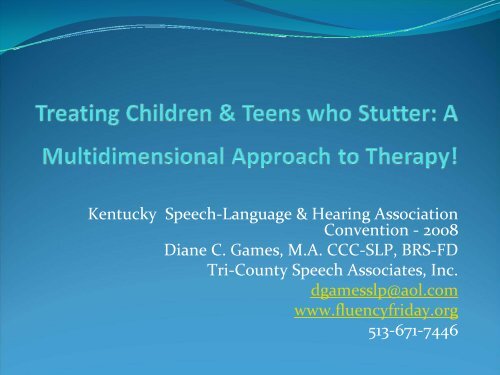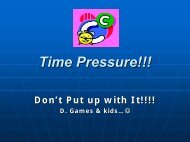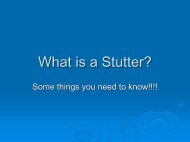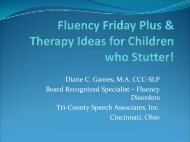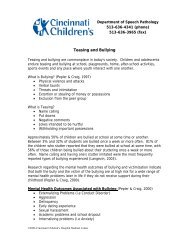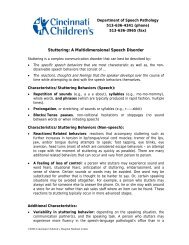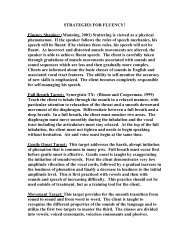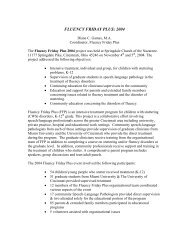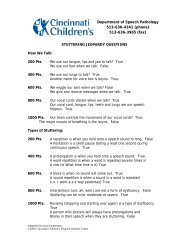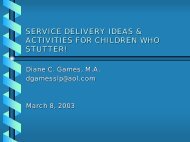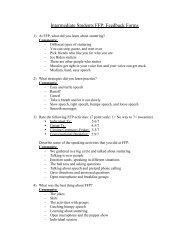Treating Children & Teens Who Stutter - Fluency Friday Plus
Treating Children & Teens Who Stutter - Fluency Friday Plus
Treating Children & Teens Who Stutter - Fluency Friday Plus
- No tags were found...
You also want an ePaper? Increase the reach of your titles
YUMPU automatically turns print PDFs into web optimized ePapers that Google loves.
Kentucky Speech‐Language & Hearing AssociationConvention ‐ 2008Diane C. Games, M.A. CCC‐SLP, BRS‐FDTri‐County Speech Associates, Inc.dgamesslp@aol.comwww.fluencyfriday.org513‐671‐7446
A look at statistics..ASHA Leader, Spring2007….• Of SLPs who had a full semester graduate course workin stuttering:1. 36.6% indicated that they would not treatinitially because a child may spontaneously recover.2. 27.7% agreed that parents should tell childrenwho stutter to speak slower to reduce stuttering.3. 64.4% did not use attitudal scales to assessstuttering.4. 43.5% were not comfortable working withchildren who stutter.
And……..5. 71.5% did not know about intervention techniques toaddress bullying.6. 32.6% could not identify the core behaviors ofstuttering.7. 42% could not differentiate between the two mainapproaches (fluency shaping & stutteringmodification) to stuttering therapy.
Evidenced Based fatigue?HOW CAN I DO IT ALL?
What is Evidence‐BasedMeasurement?• Evidence Based Practice is a perspective onclinical decision‐making that originated inmedicine.• “Evidence based medicine is the integrationof best research evidence with clinicalexpertise and patient values.”
Evidence Based PracticeClinical DecisionsScientific Evidence Client Values Clinical Expertise
Evidenced Based Measurementmeans…• Knowing what you are measuring…i.e. a behavior vs. aconcept.• Determining what measurement levels mean in termsof conclusions.• Knowing the precision of the tools: Reliability (interand intra) and Validity (complex: are we measuringwhat we need to measure?).
Our dilemma with<strong>Children</strong>/<strong>Teens</strong> who <strong>Stutter</strong>…• Evidence based practice means determining whichtreatment approaches are researched & thereforeviable. Many components of stuttering need furtherstudy.• <strong>Stutter</strong>ing is a multi‐dimensional disorder: manyresearch studies focus on one dimension.• Researching, reading and developing treatmentactivities is time consuming.
As a result……• Many treatment approaches are focused on oneissue or aspect of the disorder such as <strong>Stutter</strong>ingFrequency, Speech Rate, <strong>Stutter</strong> Like Disfluenciesor Speech naturalness.• However, documenting the impairment,disability and handicapping aspects ofstuttering cannot focus on onedimension.
Multidimensional Viewpoint…• Clinicians began looking at the A‐B‐Caspects of stuttering around 1980 (Cooper).Affective‐Behavior and Cognitive Issues• This type of approach evolved from seeing manyclients who could not carryover fluency from thetreatment room to other environments. Thisapproach evolved into other models: TheCommunication‐Social Model (Conture et. al.)
A working definition!• <strong>Stutter</strong>ing refers to the individualized and involuntary interruptions in theforward flow of speech and learned reactions thereto interacting with andgenerating associated thoughts and feelings about one’s speech, oneself as acommunicator, and in the communication world in which we live.• Etiology, yet unknown is conceptualized to relate to the interaction ofphysiological, psychological, psycholinguistic and environmental factors.• <strong>Stutter</strong>ing occurs within the context of communication system, thus affectingand being affected by all persons who communicate with the person whostutters.• <strong>Stutter</strong>ing is a diagnostic label referring to a complex, multidimensionalcomposite of behaviors, thoughts and feelings of people who stutter.
The Communication‐Emotional (C‐E) Model of <strong>Stutter</strong>ing• Developed by Edward Conture, et. al. VanderbiltUniversity (Ratner & Tetnowski, 2006)• This conceptual framework provides a means to viewempirical studies and understand the salient speech,language, learned behavior and emotional processesrelated to stuttering.
Distal Contributors• Why do some people stutter and others donot?GeneticsEnvironment
Proximal ContributorsSpeechLanguagePlanningSpeechLanguageProduction
How does this work?• Assumptions: Thoughts aretransformed into a code thatinforms the speech‐motor systemand ends in production of aword/sentence.• Lexical ‐> Retrieval ‐>Phonological components.
EXACERBATION• What causes differences in children with seemingly similarproximal characteristics? PWS may experience thesedifferences longer than so called normal speakers.• Emotional Reactivity: awareness of the mistake ordifference• Regulation: coping or concern resulting in variations in achild’s ability to “maintain performance.”
Experience…..• Overlaps ProximalContributors andExacerbation.• May include: health,sensitivity to communication,situational reactions, and/ortemperament etc.
Communication‐Social Model may explain…..• Coping Behaviors/Reactions to <strong>Stutter</strong>ing:• Avoidance of sounds/words/speaking• Poor carryover of fluency enhancing strategies• Denial of problem• Need for perfection• Unusual speech behaviors/overuse of fillers, etc.
Applied to children/teens who stutter.
IDEA 2004• 1) A change from “performance” to “academic,nonacademic & functional performance”. This isa positive move for qualifying children/teens whostutter.• 2) Increases emphasis on “academic,nonacademic & extracurricular activities
IDEA 2004 also….• 3) eliminates the requirement of benchmarks orshort‐term objectives, except for children withdisabilities who take alternate assessmentsaligned to alternate achievement standards.• 4) makes observations of coping behaviors and astudent’s reactions to stuttering as important asmoments of disfluency.
What does this mean to slps & tochildren who stutter?
What Behaviors might Affect SchoolPerformance?• Decreased participation in classroominteractions.• Difficulty giving oral presentations.• Trouble reading aloud.• Hesitant to participate in cooperativelearning/group projects.
and the student….• May be reluctant to ask the teacher questions forclarification.• Select courses/career paths that require the leastamount of communication.• Have difficulty establishing/maintaininginterpersonal relationships.
More Issues….the student• May have trouble introducing oneself whenmeeting new people.• Reveal decreased ability to verbally negotiateteasing and bullying situations.• Be absent from class when anxious aboutstuttering in class.
Adverse Effects for the student….• Reluctance to speak to adults in authority.• Avoiding asking for directions when maneuveringaround school.• Demonstrate difficulty seeking help and explainingconflicts in stressful situations.• Be embarrassed to clarify information aboutassignment deadlines.
And the student may…….• Feel that listeners focus on the stuttering rather thanthe message.• Demonstrate a decreased ability to express opinionsand ideas in a classroom discussion.• Difficulty talking on the phone to peers to discussclassroom projects/homework.
<strong>Fluency</strong> Evaluation:• Disfluency analysis….minimum of 300 words with apreference of 500 words.• <strong>Stutter</strong>ing Severity Instrument – 3• Ryan’s Protocol for Assessing <strong>Stutter</strong>ing: Increasinglinguistic complexity1. Automatic Speech: counting, alphabet, etc.2. Echoic Speech3. Reading Aloud.4. 3 minute samples: topics of choice5. General Conversation (Compare results to Normative<strong>Fluency</strong> Data)
Minute Monologues• Topic of choice: connection to child/teen• Number of words/syllables per minute• Number of disfluencies/types of disfluencies• Real Time Analysis: can be used to periodically checkchanges in fluency levels.
Attitudinal Scales/Checklists!• A‐19 for children K‐3• CAT‐R for children 7‐11 (revised 2006)• S‐24: <strong>Stutter</strong>ing Severity InstrumentThe above mentioned Attitudinal Scales can bedownloaded from www.fluencyfriday.org.New Scales: Behavior Assessment Battery for School‐Age <strong>Children</strong> <strong>Who</strong> <strong>Stutter</strong> (Brutten & Vanryckeghem,2006Plural Publishing.
ACES• Developed by Yaruss & Quesal; can be accessed fromwww.fluencyfriday.org which takes you the WesternPennsylvania web page: Click on Scott Yaruss andthen hit Resources for the current version.• Currently in process for Publication; Copy in FFPmanual.• This Evaluation Tool is completed by the Child/Teenwho stutters. It assess various aspects of fluency,attitudes and cognitive issues involved in stuttering.
CALMS Model• Healey, Susca and Trautman (2002, 2004)• Download from http://www.unl.edu/fluency/index.shtml• This evaluation tool can be used in ongoing tx and iscompleted by the clinician as the student progresses.Positive: Comprehensive look at the variables involved instuttering
Paper & Pencil Tasks….The School Aged Child <strong>Who</strong> <strong>Stutter</strong>s: WorkingEffectively with Attitudes and Emotions (Chmela& Reardon, SFA, 2001)• What’s True for You?• Count Me Out!• My Views on School!• Framing My Speech!• Hands Down!
Input from Important Observers:• Parent /Teacher Checklists (SFA: ChmelaReardon 2001).• Parent/Teacher interviewforms…www.fluencyfriday.org!!!
Other issues to consider…….•Coping Behaviors: reactions to stuttering,overuse of filler words, decreased amount oftalkingSecondary Behaviors: body movements, facialgrimacing, looking away, tapping…etc.Situational Fears: Interview/Scales•
Putting it all Together….
Writing Goals…….
What about Treatment????• Activities need to be relevant and appropriate to the goalsof the CWS or TWS…..yet address the results of theevaluation.• Motivation is an issue.• Must deal with coping behaviors such as “avoidance” ordealing with teasing.• Activities need to be target what the child/teen feels isrelevant to communication.
Where to Begin?
An explanation of thevariables.………
The Balance ofCommunication…….
Foundation of Knowledge• Normal Speaking Process1. Air from Lungs2. Vocal cords vibrate (abrupt vs. easy onset)3. Tensing (too much/we need a little)4. Timing (continuous phonation needs ocome first)5. Sounds (smooth, continuous movementsbetween sounds)
What are <strong>Stutter</strong> LikeDisfluencies?• Disfluencies havetension:• Word Repetitions• Interjections (3x)• Sound/syllable reps• Prolongations• Blocks• Multi‐Component
Strategies for ModifyingTension in Speech….
Ideas for dealing with reactionsto stuttering….• Having enough air: pausing/chunking• Using wait time before speaking
Other Strategies…• Relaxation Exercises‐ learning to relax/tense variousmuscles involved in speech production & learning generalbody tension.• Negative Practice: <strong>Stutter</strong>ing on purpose and then usingstrategy.• Triads 1) hard stutter 2) easy bounce and 3) exaggeratedslide/prolongation followed by easy transition into eachsound of the word. (can modify as needed)
Helpful Activities1) Tension Bars……1‐10: help the student rate levels.2) Visual representations of variousstrategies..drawings, stop‐yellow‐go traffic lights,etc.3) Rating Scales……overall, how is your tension/speechtoday?
Rating of <strong>Stutter</strong>ing ScaleName:_____________________________ Age:______________________________________________________________________HOW MUCH DO YOU STUTTER?A LOT * SOMETIMES * VERY LITTLEAT HOME: 7 6 5 4 3 2 1AT SCHOOL:7 6 5 4 3 2 1WITH FRIENDS:7 6 5 4 3 2 1WITH NEW PEOPLE:7 6 5 4 3 2 1
It is okay to have abad day or toughexperience…..Learning to applyvariousstrategies/ideas isa process thattakes time andmust be reviewedfrequently…
What about Reactions…..
<strong>Treating</strong> Negative Thinking.
Positive Self‐Talk..• First the cws must e able to recognize negativethoughts…(writing them down as the child is speaking;making a log)• These thoughts need to be reframed into postive thoughts.Stinkin’ Thinkin’ vs. Friendly Thinkin’! (Bennett)• Changing Thoughts Worksheet!• Points to Ponder: thinking about the use of certain words.
Developing the Positives..
Feelings• <strong>Who</strong> am I? – a list of adjectives to describe. FFP weuse an activity called “All About Me”!• Alphabet Feelings: generating a list of emotionsbeginning with each letter of the alphabet.• Gentle questioning: “I am wondering how you werefeeling when you were giving your talk”. “I amthinking about kids who are teased…how do youthink they might feel?”
Feelings cont….• The <strong>Stutter</strong>ing Monster: draw a picture of whatstuttering looks like to them.• Make discussion webs: the center is the situation, thespokes are things that happen in that situation; theborders are possible ways to handle the situation.
Maintaining <strong>Fluency</strong>• Relapse: more likely to occur in CWS who have beenstuttering longer. CWS may relapse due to habitstrength, poor self‐monitoring skills, not takingresponsibility for change or strength ofcoping/reaction behaviors.• Prepare your students for relapse. “Normalize”relapse as part of dealing with stuttering. It is goingto happen. Help them understand WHY? Also tounderstand that sometimes there is not explanation.
Situational Variables…..• Traffic Light to represent talking situations that are a“Green ‐ Go”……little difficulty; “Yellow ‐Caution”…..sometimes a problem; and “Red –Stop”….are very difficult. These can be evaluatedperiodically…attached with sticky tape.• List making…….”pick the situations that are importantto you”.
I am the Expert!• Giving a talk to classmates: FFP web page contains asample Power Point: Irv Wollman & Ricky.• Sharing information with peers and teachers.• NSA has a handout to facilitate this process.
Assessment & Treatment Considerations
Precepts about PS children• Time of intense development: social,physical, cognitive, & speech/language!• Play and fun represent the language ofchildhood• <strong>Children</strong> are insightful, but tend to do andreflect whatever they are told.• People of all ages have a story to tell….
The 3 P’s• Predisposing Factors: family history of stutteringor other neurological factors.• Precipitating Factors: rapid speech and languagedevelopment accompanied by demands from theenvironment.• Perpetuating Factors: critical home environment,high expectations from family in terms oflanguage, development ofbehaviors/reactions…i.e. stuttering; child’ssensitivity to problem/corrections!
Assessment• Case History: genetics, onset of problem, othermedical and developmental history.• Parent Interview: assessment of the problem in anumber of settings• Home/parent/siblings Interactions(who, what, when, and level of disfluency)(video/taped sample from home)• Child‐Parent Interactions in a session
Assessment Continued• Structured Child‐Clinician Interactions includingfluency disruptors & tasks requiring longer and morecomplex responses• Standardized Measures of Phonological and LanguageDevelopment• Calculating the amount and types of disfluenciespresent in each interaction.• Recommendations may include a period of treatmentand need to include parent training
Prognostic & Critical Factors• How long has the childbeen stuttering?• What is the nature ofthe reactions from thechild’s environment?• Is the child aware of thedisfluencies?• What kinds of strategieshave been attempted todeal with the disfluency?• What type of disfluencyis the childdemonstrating?• How committed andinvolved are theparents?• What is the cognitivelevel of the child?• Are there other issues inthe child’s life?
Yairi et al…..• Prevalence: 2.1:1 M:F• Age of Onset: Mean 33.38months (typically 2‐4)• Pattern: Sudden to Gradual notsignificant• Parents accurate in ratingseverity• Significant: Family History,Gender, Age of onset, SLD,Disfluency Length, Type andDuration• Concomitant Disorders;AwarenessAGE• Comparing SLD: DisfluenciesSLD: PSPSWS NORMAL2 10.15/100(syllables)1.22/1003 11.75/100 1.6/1004 6.87/100 0.91/100All 10.37/100 1.33/100
PS Treatment‐Parents• Teach parents to respond/interact to the childw/o drawing attention to the disfluency.• Encourage good listening skills• Simplify, slow and soften the daily speech model(pacing)
Parents‐Cont.• Give the child as many fluent talking experiences aspossible. Pace speech slightly slower as a model.• Keep “stuttering” from becoming aproblem…normalizing the fact that “bumpy” speechhappens to many children.• Identify, reduce or eliminate fluency disruptors…turntaking with siblings, multiple languages in household,time pressure etc.
Parents of CWS• Speech Rate? Not really a factor, but pacing is…if you slow,then the child is more likely to follow.• Interruptions: these behaviors increase as a function of morestuttering.• Turn Taking: highly variable across cws but may be a factor.• Question usage: not a factor in stuttering but commenting oftenreduces the anxiety/demand of responding.• Eye Contact: mothers of cws often provide this more frequently
Direct Intervention ‐ PS• Goals include generating spontaneous fluency and apositive attitude toward fluency and oneself as acommunicator.• Objectives are targeted in play with transfer as the maingoal.• Provide vocabulary to talk about communication.• Number and Frequency of Sessions can be adjusted as thechild progresses.
Procedures• Establish fluency in basic communication tasks.• Develop a resistance to fluency disruptors by increasingthe complexity and length of the speaking situations.• Encourage discussions of feelings aboutcommunication…in a simple way!• Maintain fluency enhancing interactions in all settings.
Direct vs. Indirect Treatment• Treatment Options‐ the slp can select a number ofoptions based on the child’s need, the needs of theparents and the risk factors from the assessment.• PS Tx should include a Parent Training Portion: i.e.ways to interact to improve fluency and to problemsolve ways to handle various disruptors.


